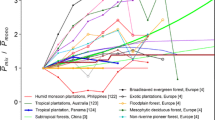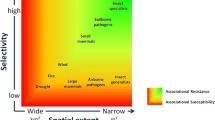Abstract
Understanding community dynamics during early life stages of trees is critical for the prediction of future species composition. In Mediterranean forests drought is a major constraint for regeneration, but likely not the only factor determining the observed spatial patterns. We carried out a sowing experiment aimed at identifying main filters during seed-seedling transition. Specifically, we studied seed fate (predation, fungi infection, emergence) and subsequent seedling performance (mortality during the first summer and overall recruitment after 2 years) of four co-occurring Mediterranean tree species (Quercus ilex, Quercus faginea, Juniperus thurifera, Pinus nigra). We related these processes to the dominant species composition, microhabitat heterogeneity, herb cover and seed mass. The identity of the dominant species in the forest canopy was more important for recruitment than the forest canopy being dominated by conspecific vs. heterospecific species. The patterns we found suggest that biotic interactions such as facilitation (lower mortality under the canopies) and herb competition (during emergence of J. thurifera) are relevant during recruitment. Moreover, our results pointed to ontogenetic conflicts regarding the seed mass of Q. faginea and to density-dependent seed mortality for Q. ilex, rarely described in Mediterranean ecosystems. We propose that our study species experience population growth in forests dominated by heterospecifics where the recruitment success depends on habitat heterogeneity and on moderated biotic and abiotic stresses created by each species. Our results reveal patterns and mechanisms involved in recruitment constraints that add complexity to the well-known drought-related processes in Mediterranean ecosystems.



Similar content being viewed by others
References
Agresti A (1996) An introduction to categorical data analysis. Wiley, New York
Bates D, Maechler M (2010) lme4: linear mixed-effects models using S4 classes. R package version 0.999375-35. http://CRAN.R-project.org/package=lme4
Bossema I (1979) Jays and oaks. Eco-ethological study of a symbiosis. Behaviour 70:1–117. doi:10.1163/156853979x00016
Bruno JF, Stachowicz JJ, Bertness MD (2003) Inclusion of facilitation into ecological theory. Trends Ecol Evol 18(3):119–125. doi:10.1016/s0169-5347(02)00045-9
Burnham KP, Anderson DR (2002) Model selection and multimodel inference: a practical information-theoretic approach. Springer, New York
Callaway RM (1995) Positive interactions among plants. Bot Rev 61(4):306–349. doi:10.1007/bf02912621
Castillo JM, Rubio-Casal Alfredo E, Luque CJ, Luque T, Figueroa ME (2002) Comparative field summer stress of three tree species co-occurring in Mediterranean coastal dunes. Photosynthetica 40(1):49–56
Castro J, Zamora R, Hódar JA, Gómez JM (2004) Seedling establishment of a boreal tree species (Pinus sylvestris) at its southernmost distribution limit: consequences of being in a marginal Mediterranean habitat. J Ecol 92:266–277
Castro J, Zamora R, Hódar JA, Gómez JM (2005) Alleviation of summer drought boosts establishment success of Pinus sylvestris in a Mediterranean mountain: an experimental approach. Plant Ecol 181(2):191–202. doi:10.1007/s11258-005-6626-5
Chesson P (2000) Mechanisms of maintenance of species diversity. Annu Rev Ecol Syst 31:343–366. doi:10.1146/annurev.ecolsys.31.1.343
Clark JS, Beckage B, Camill P, Cleveland B, HilleRisLambers J, Lichter J, McLachlan J, Mohan J, Wyckoff P (1999) Interpreting recruitment limitation in forests. Am J Bot 86:1–16
Connell JH (1971) On the role of natural enemies in preventing competitive exclusion in some marine animals and in rain forest trees. In: Den Boer PJ, Gradwell G (eds) Dynamics of populations. PUDOC, Wageningen, pp 298–312
Cuesta B, Villar-Salvador P, Puertolas J, Benayas JMR, Michalet R (2010) Facilitation of Quercus ilex in Mediterranean shrubland is explained by both direct and indirect interactions mediated by herbs. J Ecol 98:687–696. doi:10.1111/j.1365-2745.2010.01655.x
Defossez E, Courbaud B, Marcais B, Thuiller W, Granda E, Kunstler G (2011) Do interactions between plant and soil biota change with elevation? A study on Fagus sylvatica. Biol Lett 7:699–701. doi:10.1098/rsbl.2011.0236
Emery SM, Gross KL (2007) Dominant species identity, not community evenness, regulates invasion in experimental grassland plant communities. Ecology 88(4):954–964
Escribano-Ávila G, Sanz-Pérez V, Pías B, Virgós E, Escudero A, Valladares F (2012) Colonization of abandoned land by Juniperus thurifera is mediated by the interaction of a diverse dispersal assemblage and environmental heterogeneity. PLoS One 7:e46993. doi:10.1371/journal.pone.0046993
Escudero A, Somolinos RC, Olano JM, Rubio A (1999) Factors controlling the establishment of Helianthemum squamatum, an endemic gypsophile of semi-arid Spain. J Ecol 87(2):290–302. doi:10.1046/j.1365-2745.1999.00356.x
Flexas J, Díaz-Espejo A, Gago J, Gallé A, Galmés J, Gulías J, Medrano H (2014) Photosynthetic limitations in Mediterranean plants: a review. Environ Exp Bot 103:12–23. doi:10.1016/j.envexpbot.2013.09.002
Friendly M (1994) Mosaic displays for multiway contingency-tables. J Am Stat Assoc 89(425):190–200
Friendly M (1999) Extending mosaic displays: marginal, conditional, and partial views of categorical data. J Comput Graph Stat 8(3):373–395
García-Fayos P, Sainz P, Melero JP (2008) Germinación de Juniperus thurifera. Centro de investigaciones sobre desertificación—(CSIC-UV-GV)
Gómez JM (2003) Spatial patterns in long-distance dispersal of Quercus ilex acorns by jays in a heterogeneous landscape. Ecography 26(5):573–584. doi:10.1034/j.1600-0587.2003.03586.x
Gómez JM (2004) Bigger is not always better, conflicting selective pressures on seed size in Quercus ilex. Evolution 58:71–80. doi:10.1111/j.0014-3820.2004.tb01574.x
Gómez JM, Hódar JA (2008) Wild boars (Sus scrofa) affect the recruitment rate and spatial distribution of holm oak (Quercus ilex). For Ecol Manage 256(6):1384–1389. doi:10.1016/j.foreco.2008.06.045
Gómez JM, García D, Zamora R (2003) Impact of vertebrate acorn- and seedling-predators on a Mediterranean Quercus pyrenaica forest. For Ecol Manage 180:125–134. doi:10.1016/s0378-1127(02)00608-4
Gómez-Aparicio L, Valladares F, Zamora R, Quero JL (2005) Response of tree seedlings to the abiotic heterogeneity generated by nurse shrubs: an experimental approach at different scales. Ecography 28(6):757–768. doi:10.1111/j.2005.0906-7590.04337.x
Gómez-Aparicio L, Valladares F, Zamora R (2006) Differential light responses of Mediterranean tree saplings: linking ecophysiology with regeneration niche in four co-occurring species. Tree Physiol 26(7):947–958. doi:10.1093/treephys/26.7.947
Gómez-Aparicio L, Ibáñez B, Serrano MS, De Vita P, Avila JM, Pérez-Ramos IM, García LV, Sánchez EM, Marañón T (2012) Spatial patterns of soil pathogens in declining Mediterranean forests: implications for tree species regeneration. New Phytol 194(4):1014–1024. doi:10.1111/j.1469-8137.2012.04108.x
González A, Loreau M (2009) The causes and consequences of compensatory dynamics in ecological communities. Annu Rev Ecol Evol Syst 40(1):393–414. doi:10.1146/annurev.ecolsys.39.110707.173349
González-Rodríguez V, Villar R (2012) Post-dispersal seed removal in four Mediterranean oaks: species and microhabitat selection differ depending on large herbivore activity. Ecol Res 27(3):587–594. doi:10.1007/s11284-012-0927-7
González-Rodríguez V, Barrio IC, Villar R (2012) Within-population variability influences early seedling establishment in four Mediterranean oaks. Acta Oecol-Int J Ecol 41:82–89. doi:10.1016/j.actao.2012.04.008
Gotelli NJ, Ellison AM (2004) A primer of ecological statistics. Sinauer, Massachusetts
Granda E, Escudero A, de la Cruz M, Valladares F (2012) Juvenile-adult tree associations in a continental Mediterranean ecosystem: no evidence for sustained and general facilitation at increased aridity. J Veg Sci 23(1):164–175. doi:10.1111/j.1654-1103.2011.01343.x
HilleRisLambers J, Clark JS, Beckage B (2002) Density-dependent mortality and the latitudinal gradient in species diversity. Nature 417(6890):732–735. doi:10.1038/nature00809
Holmgren M, Gómez-Aparicio L, Quero JL, Valladares F (2012) Non-linear effects of drought under shade: reconciling physiological and ecological models in plant communities. Oecologia 169(2):293–305. doi:10.1007/s00442-011-2196-5
Hulme PE (1998) Post-dispersal seed predation: consequences for plant demography and evolution. Perspect Plant Ecol Evol Syst 1(1):32–46. doi:10.1078/1433-8319-00050
Janzen DH (1970) Herbivores and number of tree species in tropical forests. Am Nat 104(940):501–528
Kunstler G, Curt T, Bouchaud M, Lepart J (2006) Indirect facilitation and competition in tree species colonization of sub-Mediterranean grasslands. J Veg Sci 17(3):379–388. doi:10.1111/j.1654-1103.2006.tb02458.x
Lloret F, Casanovas C, Peñuelas J (1999) Seedling survival of Mediterranean shrubland species in relation to root:shoot ratio, seed size and water and nitrogen use. Funct Ecol 13(2):210–216. doi:10.1046/j.1365-2435.1999.00309.x
Lloret F, Escudero A, Iriondo JM, Martínez-Vilalta J, Valladares F (2012) Extreme climatic events and vegetation: the role of stabilizing processes. Glob Change Biol 18(3):797–805. doi:10.1111/j.1365-2486.2011.02624.x
Maestre FT, Cortina J, Bautista S (2004) Mechanisms underlying the interaction between Pinus halepensis and the native late-successional shrub Pistacia lentiscus in a semi-arid plantation. Ecography 27(6):776–786. doi:10.1111/j.0906-7590.2004.03990.x
McCarthy-Neumann S, Kobe RK (2010) Conspecific and heterospecific plant-soil feedbacks influence survivorship and growth of temperate tree seedlings. J Ecol 98:408–418. doi:10.1111/j.1365-2745.2009.01620.x
McIntire EJB, Fajardo A (2014) Facilitation as a ubiquitous driver of biodiversity. New Phytol 201:403–416. doi:10.1111/nph.12478
Muñoz A, Bonal R (2007) Rodents change acorn dispersal behaviour in response to ungulate presence. Oikos 116(10):1631–1638. doi:10.1111/j.2007.0030-1299.15710.x
Packer A, Clay K (2000) Soil pathogens and spatial patterns of seedling mortality in a temperate tree. Nature 404(6775):278–281. doi:10.1038/35005072
Paine CE, Norden N, Chave J, Forget PM, Fortunel C, Dexter KG, Baraloto C (2012) Phylogenetic density dependence and environmental filtering predict seedling mortality in a tropical forest. Ecol Lett 15(1):34–41. doi:10.1111/j.1461-0248.2011.01705.x
Perea R, Miguel AS, Gil L (2011) Acorn dispersal by rodents: the importance of re-dispersal and distance to shelter. Basic Appl Ecol 12(5):432–439. doi:10.1016/j.baae.2011.05.002
Pérez-Ramos IM, Urbieta IR, Marañón T, Zavala MA, Kobe RK (2008) Seed removal in two coexisting oak species: ecological consequences of seed size, plant cover and seed-drop timing. Oikos 117(9):131–140. doi:10.1111/j.2008.0030-1299.16370.x
Pérez-Ramos IM, Urbieta IR, Zavala MA, Marañón T (2012) Ontogenetic conflicts and rank reversals in two Mediterranean oak species: implications for coexistence. J Ecol 100(2):467–477. doi:10.1111/j.1365-2745.2011.01912.x
Peters HA (2003) Neighbour-regulated mortality: the influence of positive and negative density dependence on tree populations in species-rich tropical forests. Ecol Lett 6(8):757–765. doi:10.1046/j.1461-0248.2003.00492.x
Pinheiro J, Bates D, DebRoy S, Sarkar D, Team tRDC (2000) nlme: linear and nonlinear mixed effects models
Pugnaire FI, Armas C, Maestre FT (2011) Positive plant interactions in the Iberian Southeast: mechanisms, environmental gradients, and ecosystem function. J Arid Environ 75(12):1310–1320. doi:10.1016/j.jaridenv.2011.01.016
Pulido FJ, Díaz M (2005) Regeneration of a Mediterranean oak: a whole-cycle approach. Ecoscience 12(1):92–102. doi:10.2980/i1195-6860-12-1-92.1
Pyke DA, Thompson JN (1986) Statistical-analysis of survival and removal rate experiments. Ecology 67(1):240–245. doi:10.2307/1938523
R Core Team (2012) R: A language and environment for statistical computing. R Foundation for Statistical Computing, Vienna. ISBN 3-900051-07-0. http://www.R-project.org
Santos T, Telleria JL, Virgos E (1999) Dispersal of Spanish juniper Juniperus thurifera by birds and mammals in a fragmented landscape. Ecography 22:193–204
Schupp EW (1995) Seed-seedling conflicts, habitat choice and patterns of plant recruitment. Am J Bot 82(3):399–409
Torre I, Díaz M, Martínez-Padilla J, Bonal R, Vinuela J, Fargallo JA (2007) Cattle grazing, raptor abundance and small mammal communities in Mediterranean grasslands. Basic Appl Ecol 8(6):565–575. doi:10.1016/j.baae.2006.09.016
Uriarte M, Condit R, Canham CD, Hubbell SP (2004) A spatially explicit model of sapling growth in a tropical forest: does the identity of neighbour matter? J Ecol 92:348–360. doi:10.1111/j.0022-0477.2004.00867.x
Webb CO, Gilbert GS, Donoghue MJ (2006) Phylodiversity-dependent seedling mortality, size structure, and disease in a Bornean rain forest. Ecology 87(7):123–131
Wright SJ (2002) Plant diversity in tropical forests: a review of mechanisms of species coexistence. Oecologia 130(1):1–14. doi:10.1007/s004420100809
Wu J, Loucks OL (1995) From balance of nature to hierarchical patch dynamics: a paradigm shift in ecology. Q Rev Biol 70(4):439–466
Acknowledgments
We are very grateful to Mario Díaz for assistance in rodent sampling, Sasha Wright for comments on statistical methods and to all the people who helped in the field, especially David López and Gonzalo Caballé. We also thank the Junta de Castilla-La Mancha, the director and park rangers of the Alto Tajo Natural Park for permission and facilities provided. We thank the editor and the anonymous reviewers for their constructive comments, which helped us to improve the manuscript. The experiments comply with the current laws of the country (Spain) in which the experiments were performed. This work was supported by the Spanish Ministry for Innovation and Science with the grants FPI (CGL2007-66066-C04-02) to E. G., Consolider Montes (CSD2008 00040), VULGLO (CGL2010 22180 C03 03) and MOUNTAINS (CGL-2012-38427), and by the Community of Madrid grant REMEDINAL 2 (CM S2009 AMB 1783).
Author information
Authors and Affiliations
Corresponding author
Additional information
Communicated by Ines Ibanez.
Electronic supplementary material
Below is the link to the electronic supplementary material.
Rights and permissions
About this article
Cite this article
Granda, E., Escudero, A. & Valladares, F. More than just drought: complexity of recruitment patterns in Mediterranean forests. Oecologia 176, 997–1007 (2014). https://doi.org/10.1007/s00442-014-3064-x
Received:
Accepted:
Published:
Issue Date:
DOI: https://doi.org/10.1007/s00442-014-3064-x




